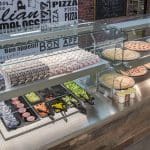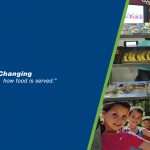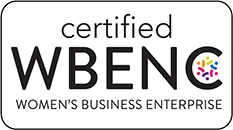Layout improvements are how to make school lunch lines faster The K-12 lunch period is…
Nine Lives of Cafeteria Serving Lines: Avoid These Common Pitfalls

We are back with another installment of LTI’s Right Way/Wrong Way series. There are a variety of common mistakes made during the serving line design phase and operational procedures that can impede a successful foodservice operation. Serving food “the wrong way” can lead to limited offerings, reduced efficiencies, long lines and decreases in participation rates — not to mention the creation of safety hazards.
So, take a moment to learn some tips from the LTI experts about the additional ways foodservice operators might be jeopardizing efficiency or safety.
Haven’t seen Part One of this series? Check it out here.
Wrong Way #6: Mounding or heaping foods in the wells
It’s natural for servers to want to show off their menu items, and many tend to mound food in pans attempting to do so. But to comply with NSF performance standards, you should avoid mounding or heaping menu items in food wells for these reasons:
- Food safety: Mounding or heaping menu items places the food out of the heating or cooling zones. The NSF 4 and 7 standard performance tests require temperatures taken one inch below the food’s surface. If you are mounding food, your food offering will not hold temperature.
- Aesthetics: Mounding or heaping menu items might look appealing at the start, but it quickly makes the serving line look messy and unappetizing as foods easily fall out of the pans onto the counter.
- Stirring menu items: It is necessary to stir or rotate foods in pans for quality purposes and distributing moisture and maintaining safe serving temperature. Stirring is not possible when food is mounded in a pan.
Right Way: Never make the common serving mistake of mounding food in your serving wells, whether hot or cold. Pay attention to the parameters and requirements of NSF performance standards.
Wrong Way #7: Limiting vertical serving
A recent trend sweeping school cafeterias across the country is to increase the variety of offerings available to students. But if you aren’t considering vertical serving as an option, you might quickly discover there is just not enough space on the line to support your efforts.
Limiting your vertical serving space in a cafeteria serving line can be a mistake for several reasons:
- Reduced visibility and buy-in: By limiting vertical serving space, you reduce the sight appeal of menu choices. Students eat with their eyes first, and if they can’t see all the selections at varying heights as they pass through the line, you are looking at missed opportunity.
- Poor visual appeal: Limiting vertical serving space can cause clutter and the tendency to overpack your display area, in light of the trend to offer more. This reduces your overall aesthetic appeal to students and may impact participation rates as well. Vertical merchandising maximizes the use of limited space, allowing for more products or food to be displayed in a smaller area.
- Diminished flexibility. Flexibility for day-to-day menu changes is key, and you’re missing the mark if you pass on vertical options. For instance, a frost top can be placed above a cold pan, essentially doubling the amount of display space for food selections.
Right Way: Think vertical! You can utilize LTI’s Two-Tier Glass vertical serving options for the ultimate in display flexibility and space. It allows operators to convert from a heated shelf to frost top with the flip of a switch in an hour or less and essentially doubles the amount of display space.
Wrong Way #8: Limiting convertibility
Don’t we all remember the days of COVID? The ability to drop a food shield when necessary remains a legitimate need in 2023. Issues with limiting convertibility include:
- Food safety: Convertible shields protect food from airborne contaminants such as human breath, debris and bacteria. Without shields, food can be more vulnerable to contamination, potentially leading to foodborne illnesses.
- Aesthetics: Convertible shields can help create a more appealing and professional appearance for your serving line, which can improve the overall student experience and satisfaction.
- Versatility: Convertible shields are adjustable, allowing you to customize your serving line to accommodate a variety of menu items and serving configurations, maximizing space and improving efficiency.
- Labor: Having convertible food shields enables operators to allow self-service on days when there are not enough staff to man all the serving stations.
Right Way: Utilize LTI’s convertible food shields that can flip from self-serve to full-serve in times of increased health alert or short staffing.
Wrong Way #9: Using heated or frosted shelves improperly
There has been a trend to forgo food pans altogether and place decorative platters or foods directly on a heated or frosted shelf (pizzas at an Italian station or yogurt parfaits, for example). But there are several ways in which operators are utilizing heated shelves incorrectly:
- Stacking food items on display ware: There is often a tendency to stack food items, like a platter of chicken, to increase the amount of food available in a serving line. With heated or frosted shelves, surface materials can range from hard-coat aluminum, ceramic glass and stainless steel to engineered or natural stone. Each of these surfaces has a different type of heating and or cooling source underneath, but one thing they all have in common is they may struggle to maintain proper serving temperatures, especially if there is any depth to the food. Unless you have heated lighting from above, your stacked platters will not hold temperatures appropriately.
- Not preheating or prechilling your platters: Display wares should be preheated or prechilled to keep foods at the correct temperature. In addition, each type of display ware will retain temperature differently.
Right Way: Use proper serving vessels that have be preheated or prechilled to appropriate temperatures and avoid the temptation to stack food too far above the heating element. Support each heated shelf through heated lamps with adjustable thermostats from above. And don’t forget to cover your offerings during off-peak times!
LTI Tip: Similar rules apply for cold/frosted shelves! Be cautious not to freeze the bottom of your food. You can create a slight barrier with bar matting between the serving ware and the frost top (but don’t make it too thick or the cold air won’t penetrate.
Take this list of common mistakes and conduct a thorough evaluation of your current serving line processes and identify areas for improvement. It’s essential to invest in equipment and technology that can help minimize these common mistakes and maximize your efficiency and flexibility.



